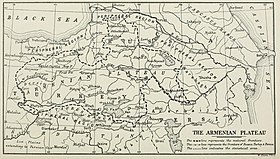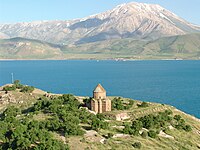Armenian highlands


The Armenian Highlands (for names in other languages see below; also known as the Armenian Upland, Armenian plateau, Armenian tableland,[1][2]) is the central-most and highest of three land-locked plateaus that together form the northern sector of the Middle East.[2] To its west is the Anatolian plateau which rises slowly from the lowland coast of the Aegean Sea and rises to an average height of 3,000 feet (910 m).[2] In Armenia, the average height rises dramatically from 3,000 feet (910 m) to 7,000 feet (2,100 m).[2] To its southeast is the Iranian plateau, where the elevation drops rapidly to an average 2,000 feet (610 m) to 5,000 feet (1,500 m) above sea level.[2]
During Antiquity, it was known as Armenia Major, a central region to the history of Armenians, and one of the three geo-political regions associated with Armenians, the other two being Armenia Minor and Sophene.[3][4] During the Middle Ages, Turkmens settled in large numbers in the Armenian Highlands.
The region was historically inhabited by Hurro-Urartian tribes, Armenians, and minorities of Georgians, Assyrians, and Greeks along the periphery. The Christian population of the Western half of the region was exterminated in an event known as the Armenian Genocide.
Today, the region is mainly inhabited by Armenians, Georgians, Kurds, Azerbaijanis, and Turks.
Name
- Template:Lang-hy Haykakan leṙnašxarh
- Turkish: Ermenistan Yaylası[5] or Ermenistan Platosu[6]
Geography
Its total area is about 400,000 km².[7] Historically, the Armenian Highlands has been the scene of great volcanic activity.[8] Geologically recent volcanism on the area has resulted in large volcanic formations and a series of massifs and tectonic movement has formed the three largest lakes in the Highland, Lake Sevan, Lake Van and Lake Urmia.[9] The Armenian Highlands is rich in water resources.[10]

Most of the Armenian Highlands is in Turkey's Eastern Anatolia Region, and also includes northwestern Iran, all of Armenia, and western Azerbaijan.[7] Its eastern parts are also known as Lesser Caucasus, which is a birthplace of Armenian people.[11]
History
From 4,000 B.C. to 1,000 B.C., tools and trinkets of copper, bronze and iron were commonly produced in this region and traded in neighboring lands where those metals were less abundant.[citation needed] It is also traditionally believed to be one of the possible locations of the Garden of Eden.[12] The Armenian Plateau has been called the "epicenter of the Iron Age", since it appears to be the location of the first appearance of Iron Age metallurgy in the late 2nd millennium BC.[13] In the Early Iron Age, the kingdom of Ararat controlled much of the region.
In Gilgamesh, the land of Aratta is placed in a geographic space that could be describing the Armenian plateau.[14]
Throughout Classical Antiquity and the Middle Ages, the Armenian Highlands was a heavily contested territory of the Byzantine, the Ottoman, the Persian, and Arab spheres of influence. Heavily contested for centuries between Persia with numerous wars raging over the region, it was finally conquered by the Ottoman Empire in the mid 17th century, and during the 19th century, it was the boundary of the Ottoman sphere of influence and the Russian sphere of influence, who had just recently completed its conquest of the Caucasus at the expense of its suzerain, Persia, in about 4 major wars spanning more than two centuries. According to Richard Hovannisian, the Armenian Genocide was the "physical elimination of the Armenian people and most of the evidence of their ever having lived on the great highland called the Armenian Plateau, to which the perpetrator side soon assigned the new name of Eastern Anatolia".[15] Since the Armenian Genocide and dissolution of the Ottoman Empire after World War I, it has been the boundary region of Turkey, Iran and the Soviet Union and, since the 1991 dissolution of the Soviet Union, Armenia, and parts of Georgia and Azerbaijan.[14]
Flora and fauna
The apricot was known by the Romans as the prunus armenicus (the Armenian plum) and was brought to Europe from the Armenian plateau.[2]
Notable peaks

| Rank | Mountain | Prominence | Location |
|---|---|---|---|
| 1 | Mount Ararat | 5,137 m | |
| 2 | Mount Aragats | 4,095 m | |
| 3 | Mount Süphan | 4,058 m | |
| 4 | Mount Kapudzhukh | 3,906 m | |
| 5 | Mount Azhdahak | 3,597 m | |
| 6 | Mount Kezelboghaz | 3,594 m | |
| 7 | Mount Artos | 3,515 m |
See also
Notes
- ^ Google Books search - Armenian tableland
- ^ a b c d e f Hewsen, Robert H. "The Geography of Armenia" in The Armenian People From Ancient to Modern Times Volume I: The Dynastic Periods: From Antiquity to the Fourteenth Century. Richard G. Hovannisian (ed.) New York: St. Martin's Press, 1997, pp. 1-17
- ^ Adalian, Rouben Paul (2010). Historical dictionary of Armenia (2nd ed. ed.). Lanham, MD: Scarecrow Press. pp. 336–8. ISBN 0810874504.
{{cite book}}:|edition=has extra text (help) - ^ Grierson, Otto Mørkholm ; edited by Philip; Westermark, Ulla (1991). Early Hellenistic coinage : from the accession of Alexander to the Peace of Apamea (336-188 B.C.) (Repr. ed.). Cambridge: Cambridge University Press. p. 175. ISBN 0521395046.
{{cite book}}:|first=has generic name (help)CS1 maint: multiple names: authors list (link) - ^ Elburz dağlarının güneyden gelen dağlarla birleştiği yere Ermenistan yaylası denir, Hürriyet Ansiklopedik Yıllığı, Hürriyet, Istanbul, 1974, p. 323.
- ^ Güneye doğru Küçük Kafkas dağları ve yüksek Ermenistan Platosu başlar. Bu plato topografik açıdan Doğu Anadolu yüksek yaylası ve İran Azerbaycanı ile birlikte bir bütün meydana getirir., Aynur Özfırat, Doğu Anadolu Yayla Kültürleri: M.Ö. II. binyıl, Arkeoloji ve Sanat Yayınları, 2001, p. 13.
- ^ a b "Armenian Highland." Encyclopædia Britannica. 2007. Encyclopædia
- ^ Volcanoes, their structure and significance Thomas George Bonney - 1912 - Page 243
- ^ Emerald Network Pilot Project in Armenia, Council of Europe.
- ^ Der Völkermord an den Armeniern, Nikolaĭ Oganesovich Oganesian - 2005- Page 6
- ^ Barbara A. West (2009). Encyclopedia of the Peoples of Asia and Oceania. Infobase Publishing. p. 47. ISBN 978-0-8160-7109-8. Retrieved 20 September 2011.
- ^ Mesopotamian Trade. Noah's Flood: The Garden of Eden, W. Willcocks, H. Rassam pp. 459-460
- ^ Lang, David M. Armenia: Cradle of Civilization. London: George Allen & Unwin, 1970, pp. 50-51, 58-59.
- ^ a b Encyclopedia of the Peoples of Asia and Oceania, By Barbara A. West, 2009, p. 47
- ^ The Armenian Genocide: Cultural and Ethical Legacies - Page 3, by Richard G. Hovannisian - 2011

